A Study on the Adsorption of Methylene Blue by Acid-Modified Coal Measures Kaolin
Abstract
:1. Introduction
2. Experimental Raw Materials, Reagents, and Methods
2.1. Experimental Raw Materials
2.2. Experimental Reagents
2.3. Experimental Method
2.3.1. Ball Mill
2.3.2. Orthogonal Experiment of Acid Modification
2.3.3. The Property Change in the Raw Material after Ball Milling and Acid Modification
2.3.4. Response Surface Optimization Experiment of Adsorption
- (1)
- Single Factor Experiment of Methylene Blue Solution Configuration Parameters and Optimal Amount of Adsorbent
- (I).
- Influence of different initial concentrations of methylene blue solution on adsorption effect
- (II).
- Influence of different pH values of methylene blue solution on adsorption effect
- (III).
- Influence of varying amounts of adsorbents on adsorption effect
- (2)
- Response Surface Optimization Experiment of Oscillating Adsorption
3. Adsorption Study
3.1. Adsorption Kinetics Study
3.2. Adsorption Thermodynamics Study
3.3. Adsorption Isotherms
4. Conclusions
Author Contributions
Funding
Data Availability Statement
Conflicts of Interest
References
- Nandi, B.K.; Goswami, A.; Purkait, M.K. Removal of cationic dyes from aqueous solutions by kaolin: Kinetic and equilibrium studies. Appl. Clay Sci. 2009, 42, 583–590. [Google Scholar] [CrossRef]
- Zhu, H.Y.; Jiang, R.; Xiao, L. Adsorption of an anionic azo dye by chitosan/kaolin/γ-Fe2O3 composites. Appl. Clay Sci. 2010, 48, 522–526. [Google Scholar] [CrossRef]
- Kiani, A.; Haratipour, P.; Ahmadi, M.; Zare-Dorabei, R.; Mahmoodi, A. Efficient removal of some anionic dyes from aqueous solution using a polymer-coated magnetic nano-adsorbent. J. Water Supply Res. Technol.—AQUA 2017, 66, 239–248. [Google Scholar] [CrossRef]
- Ghafourian, N.; Hosseini, S.N.; Mahmoodi, Z.; Masnabadi, N.; Thalji, M.R.; Abhari, A.R.; Al Zoubi, W.; Chong, K.F.; Ali, G.A.; Bakr, Z.H. TiO2-Mica 450 composite for photocatalytic degradation of methylene blue using UV irradiation. Emergent Mater. 2023, 6, 1527–1536. [Google Scholar] [CrossRef]
- Khalil, A.M.; Kenawy, S.H. Hybrid Membranes Based on Clay-Polymer for Removing Methylene Blue from Water. Acta Chim. Slov. 2020, 67, 96–104. [Google Scholar] [CrossRef] [PubMed]
- Ghosh, D.; Bhattacharyya, K.G. Adsorption of methylene blue on kaolinite. Appl. Clay Sci. 2002, 20, 295–300. [Google Scholar] [CrossRef]
- Harris, R.G.; Johnson, B.B.; Wells, J.D. Studies on the adsorption of dyes to kaolinite. Clays Clay Miner. 2006, 54, 435–448. [Google Scholar] [CrossRef]
- Nwosu, F.O.; Ajala, O.J.; Owoyemi, R.M.; Raheem, B.G. Preparation and characterization of adsorbents derived from bentonite and kaolin clays. Appl. Water Sci. 2018, 8, 195. [Google Scholar] [CrossRef]
- De Alencar, P.; Brasil, D.; Auzier, V.; Homci, R.; Bittencourt, K. Evaluation of the Kinetics of Adsorption of Methylene Blue Dye on Low Cost Ceramic Membranes Characterized with Waste from the Bayer Process. ChemRxiv 2023. [Google Scholar] [CrossRef]
- Xu, H.; Liu, J.; Chen, P.; Shao, G.; Fan, B.; Wang, H.; Chen, D.; Lu, H.; Zhang, R. Preparation of magnetic kaolinite nanotubes for the removal of methylene blue from aqueous solution. J. Inorg. Organomet. Polym. Mater. 2018, 28, 790–799. [Google Scholar] [CrossRef]
- Ren, X.; Shu, X.; Xu, H.; Huang, G.; Yuan, N.; Wen, B.; Cui, M.; Zhou, H.; Liu, X.; Li, J. Research on the Preparation of Kaolin from Coal Gangue by Flotation Decarburization with Different Collectors. Processes 2023, 11, 3075. [Google Scholar] [CrossRef]
- Wang, H.J.; Wang, X.L.; Wang, L.X. Adsorption Performance of Methylene Blue on Modified Coal Gangue. Adv. Mater. Res. 2013, 807, 521–525. [Google Scholar] [CrossRef]
- Niu, S.; Xie, X.; Wang, Z.; Zheng, L.; Gao, F.; Miao, Y. Enhanced removal performance for Congo red by coal-series kaolin with acid treatment. Environ. Technol. 2021, 42, 1472–1481. [Google Scholar] [CrossRef] [PubMed]
- Gao, J.; Lin, Q.; Yang, T.; Bao, Y.C.; Liu, J. Preparation and characterization of ZSM-5 molecular sieve using coal gangue as a raw material via solvent-free method: Adsorption performance tests for heavy metal ions and methylene blue. Chemosphere 2023, 341, 139741. [Google Scholar] [CrossRef] [PubMed]
- Barracco, F.; Parisi, E.; Pipitone, G.; Simone, E.; Bensaid, S.; Fino, D. Valorization of pyrolytic plastic-derived char for adsorption of wastewater contaminants: A kinetic and thermodynamic investigation. Int. J. Environ. Sci. Technol. 2024, 21, 6513–6530. [Google Scholar] [CrossRef]
- Flilissa, A.; Laouameur, K.; Hammoudl, N.E.; Tamam, N.; Yadav, K.K.; Achouri, B.; Alyami, A.Y.; Flilissa, O.; Algethami, J.S.; Abbas, M.; et al. Bentonite SDBS-loaded composite of methylene blue removal from wastewater: An experimental and theoretical investigation. Environ. Res. 2024, 241, 117544. [Google Scholar] [CrossRef] [PubMed]
- Mahnaz, S.T.; Zare-Dorabei, R. Competitive removal of hazardous dyes from aqueous solution by MIL-68(Al): Derivative spectrophotometric method and response surface methodology approach. Spectrochim. Acta Part A Mol. Biomol. Spectrosc. 2016, 60, 8–18. [Google Scholar]
- Seyed, H.M.; Zare-Dorabei, R.; Mohammad, B. Microwave-assisted synthesis of metal-organic framework MIL-47 for effective adsorptive removal of dibenzothiophene from model fuel. J. Iran. Chem. Soc. 2021, 18, 709–717. [Google Scholar]
- Fang, Y.; Zhao, G.; Dai, W.; Ma, L.; Ma, N. Enhanced adsorption of rubidium ion by a phenol@MIL-101(Cr) composite material. Microporous Mesoporous Mater. 2017, 251, 51–57. [Google Scholar] [CrossRef]


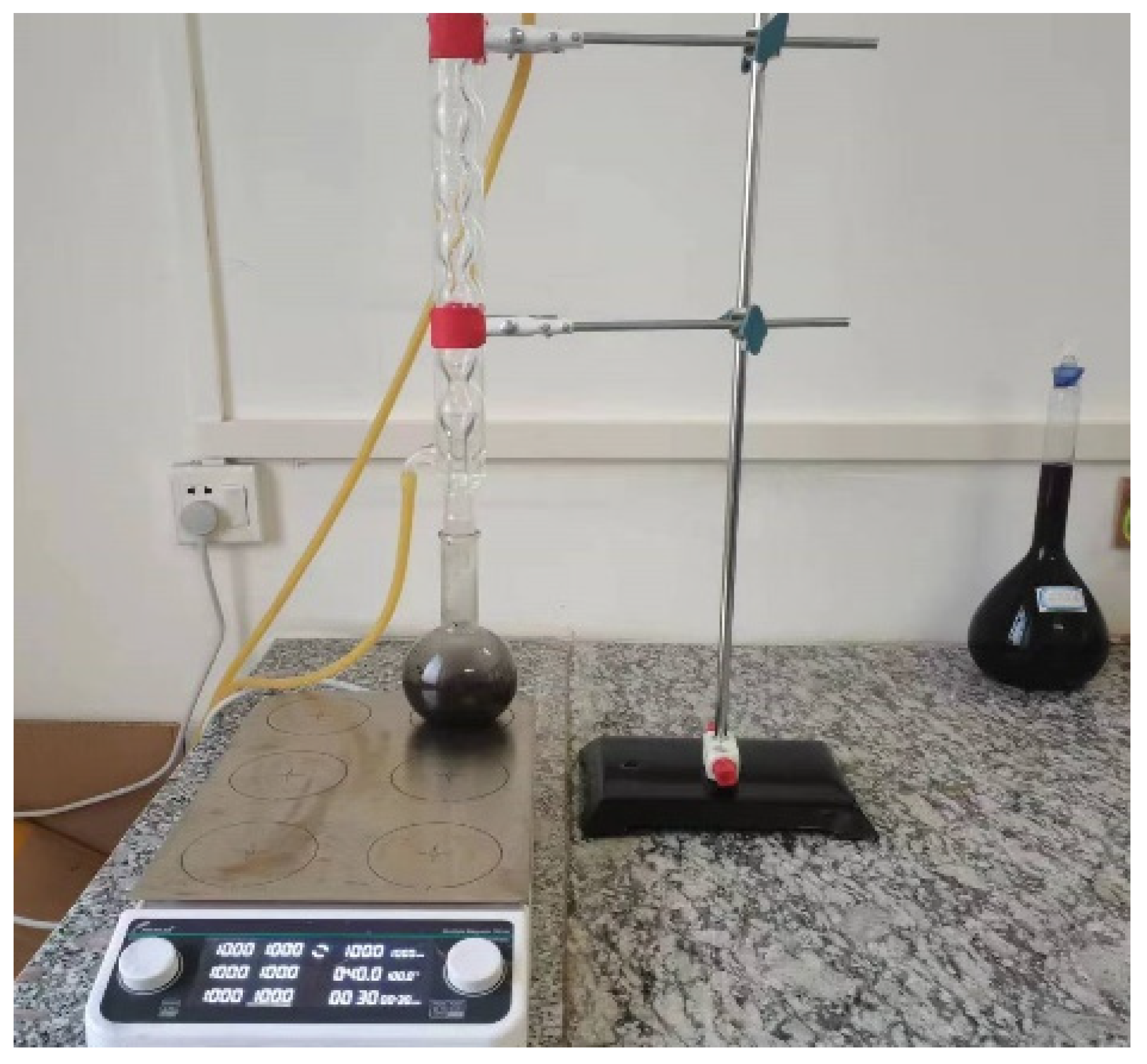
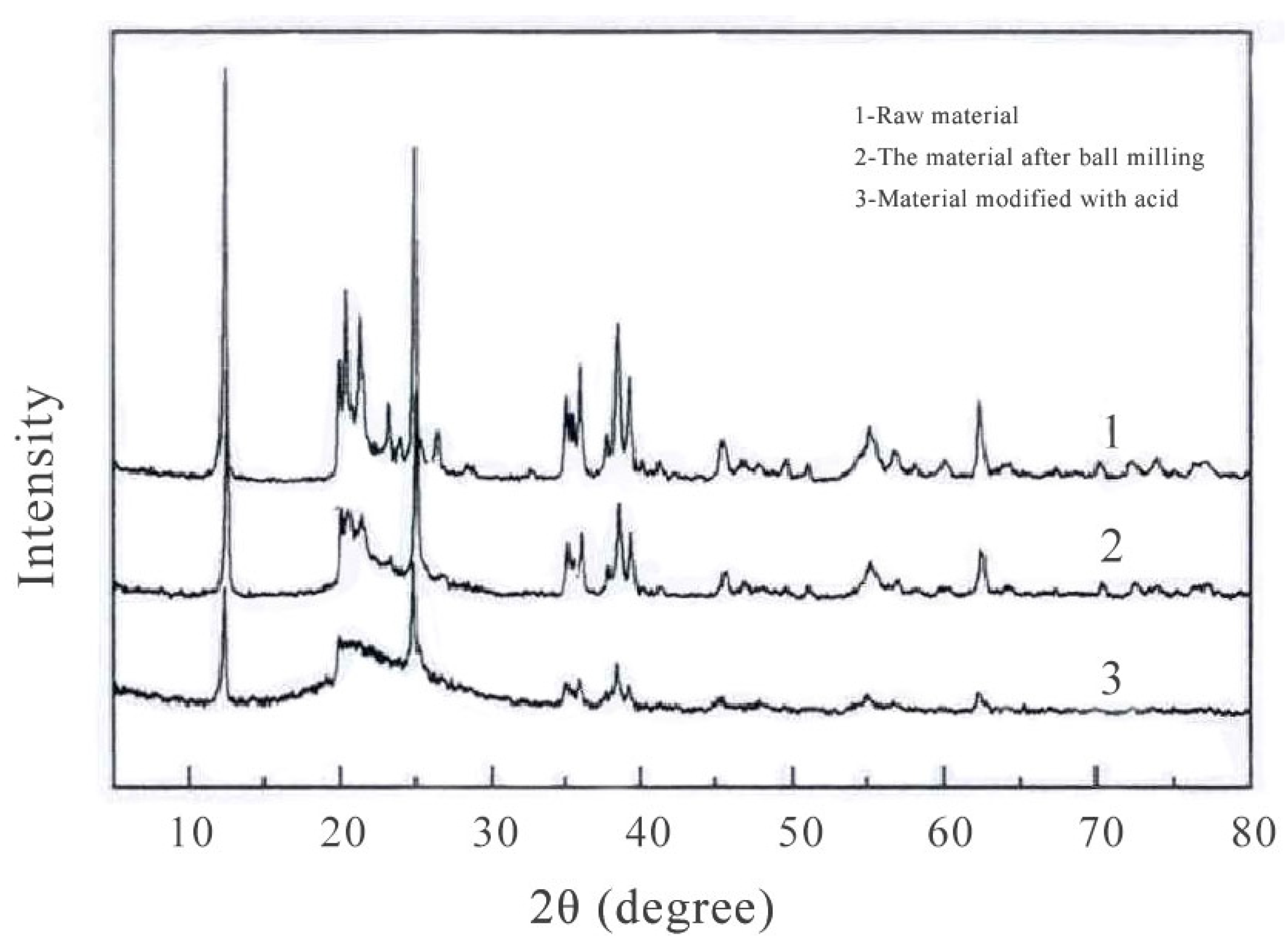

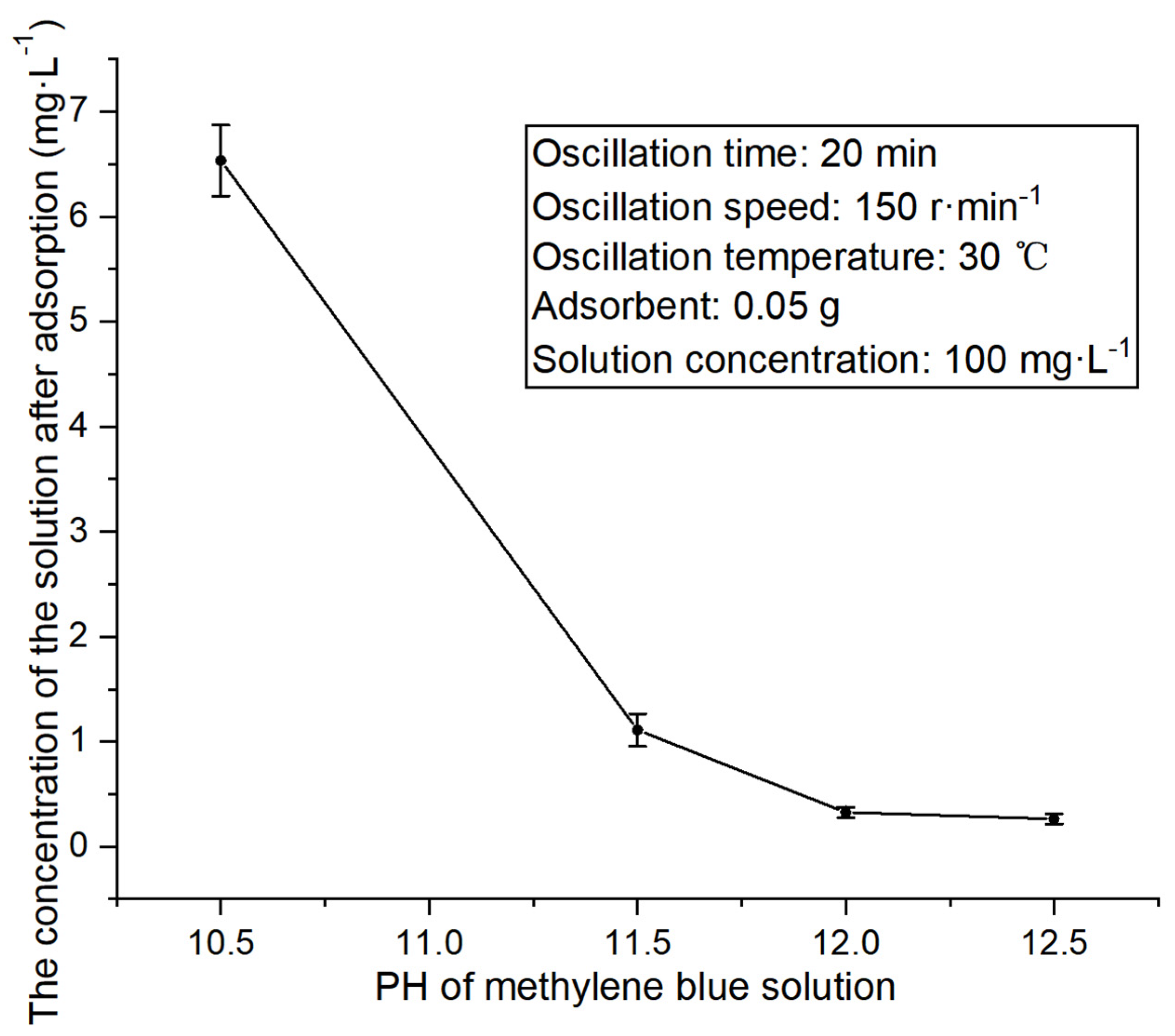
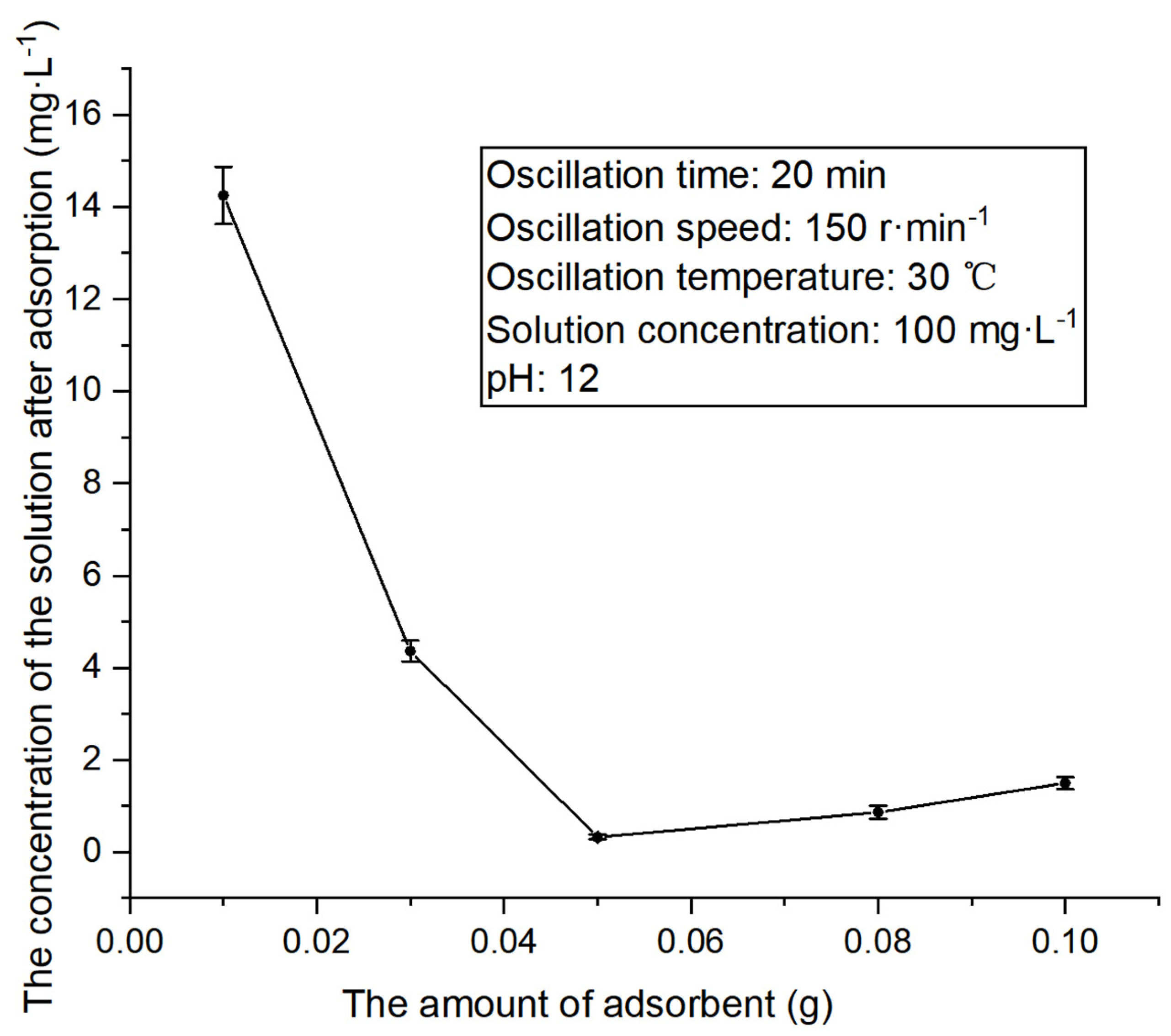
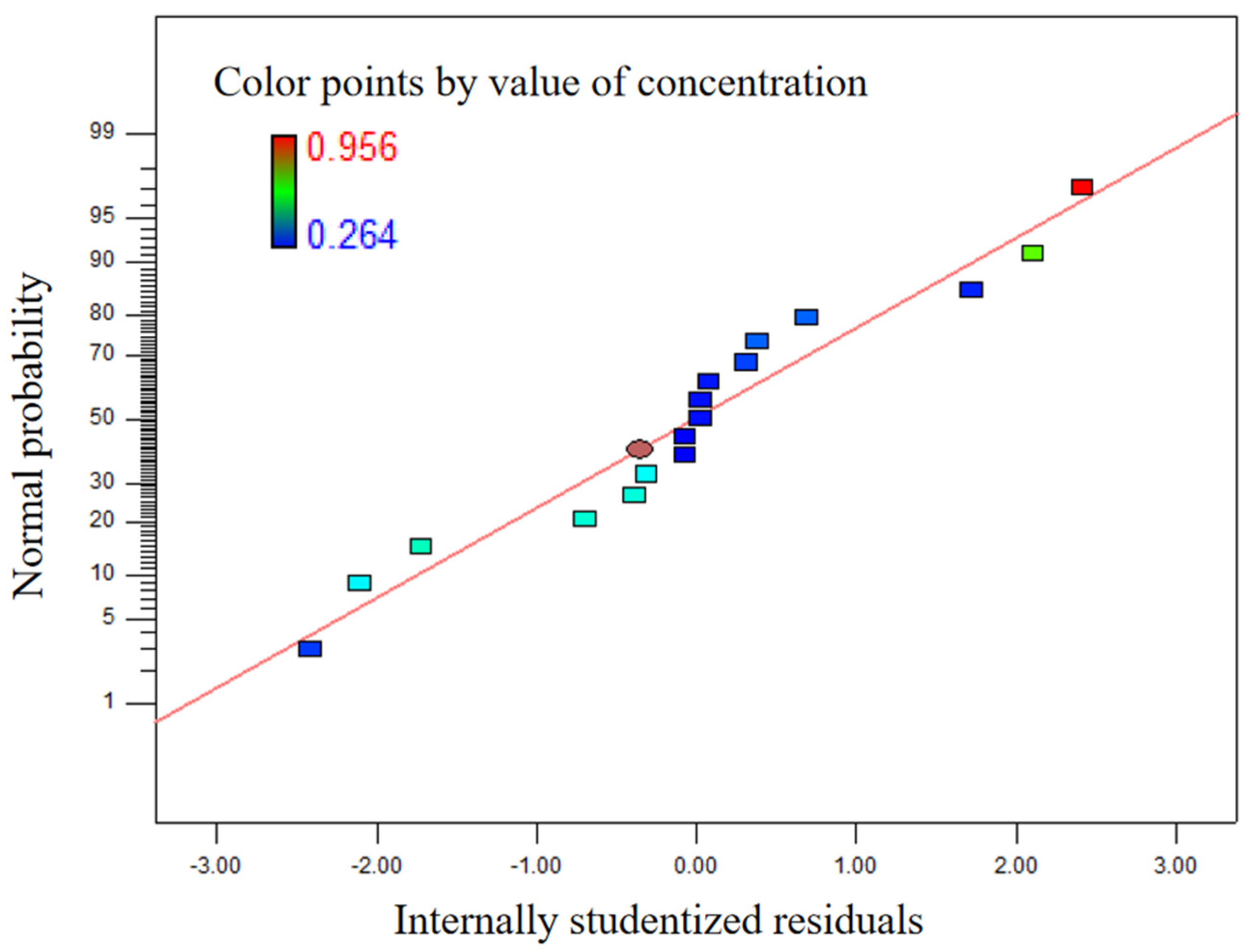

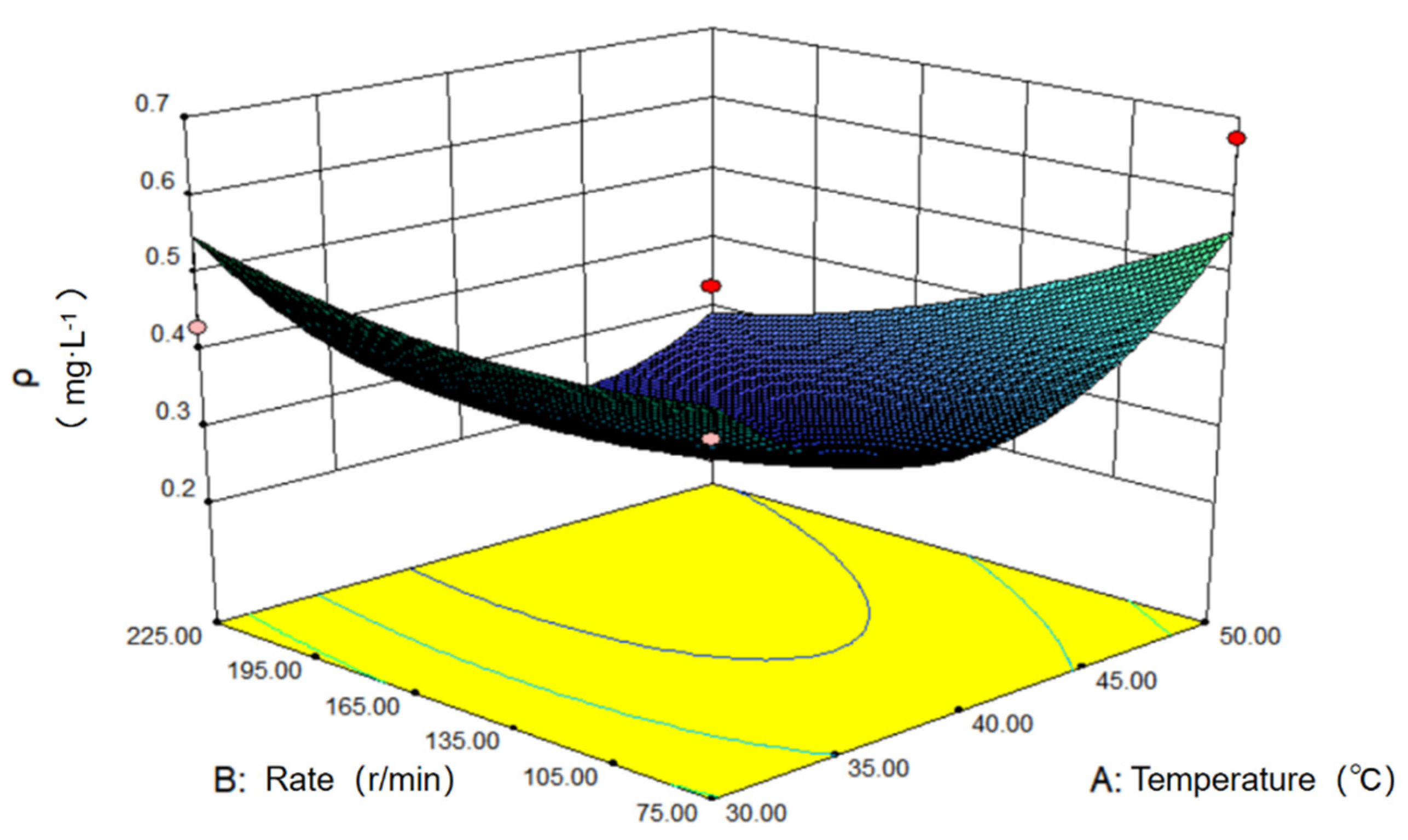


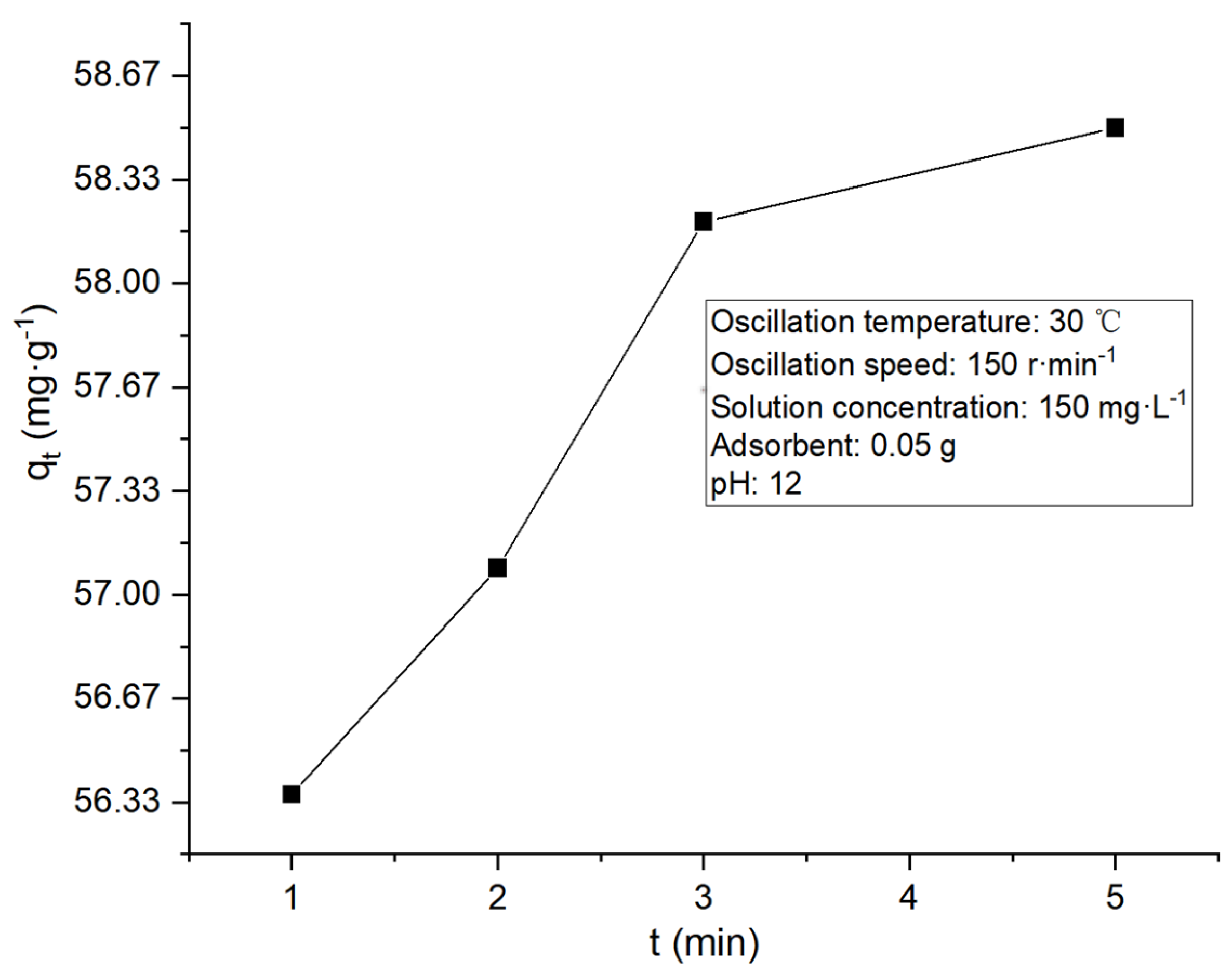
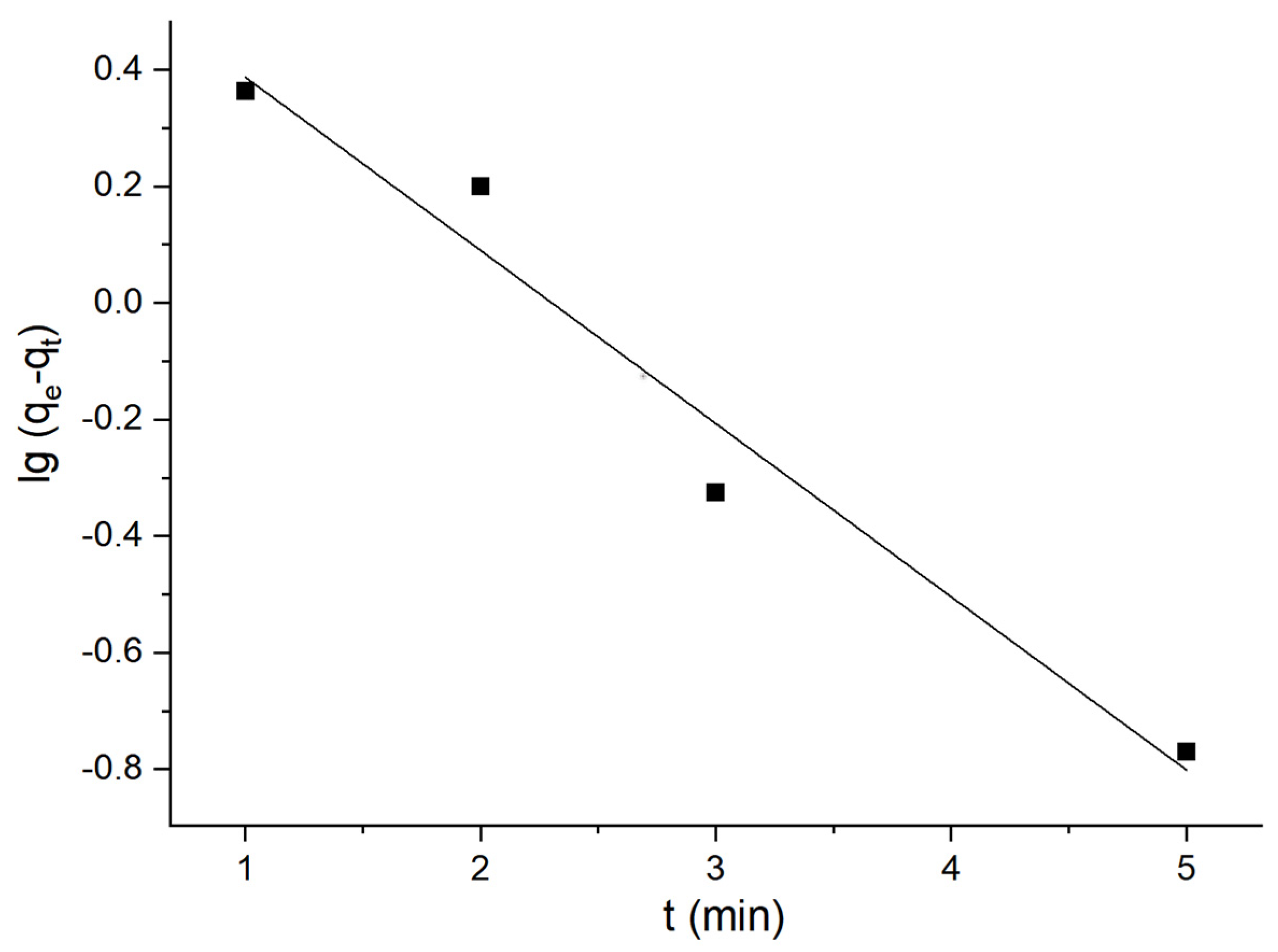

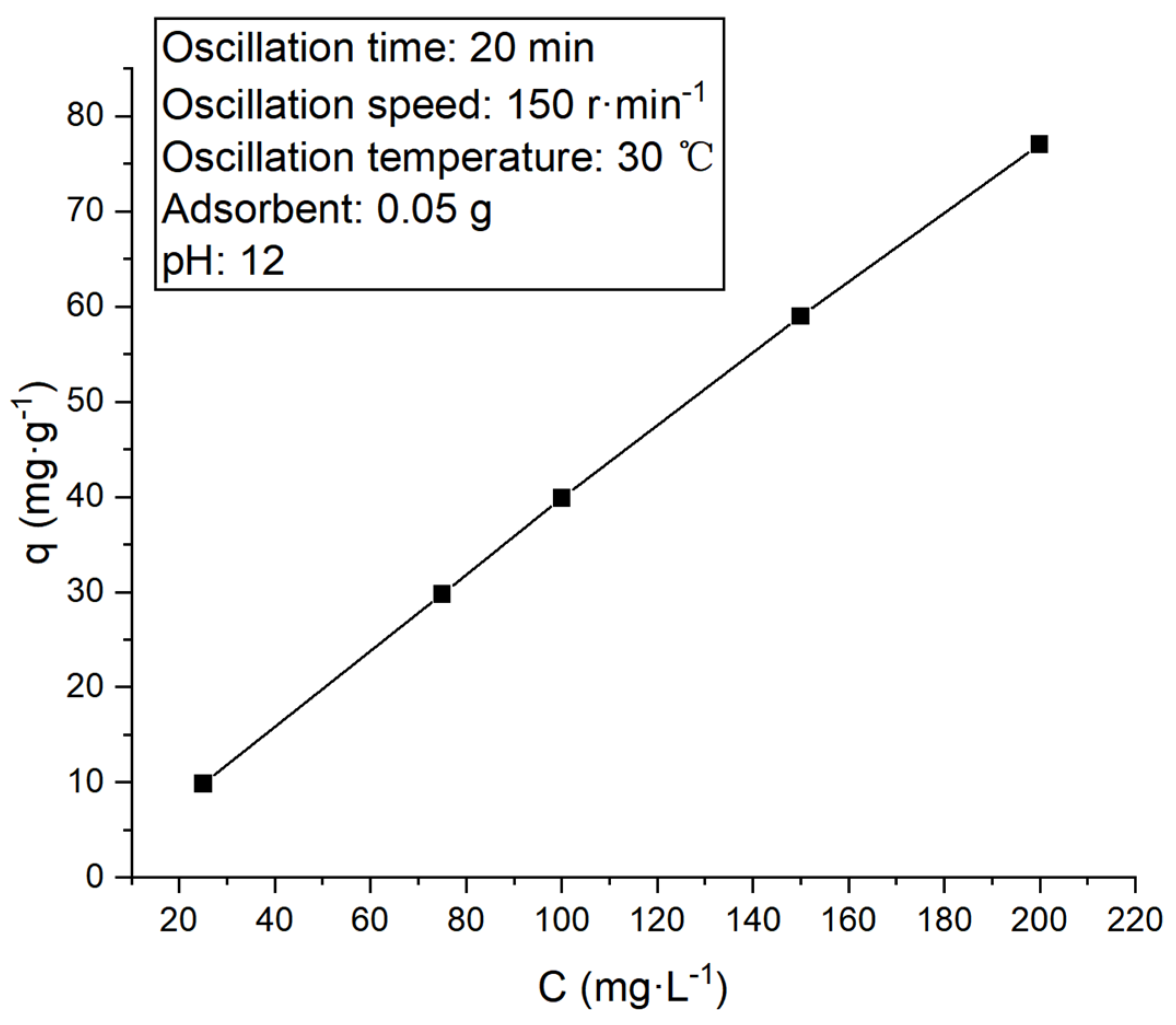

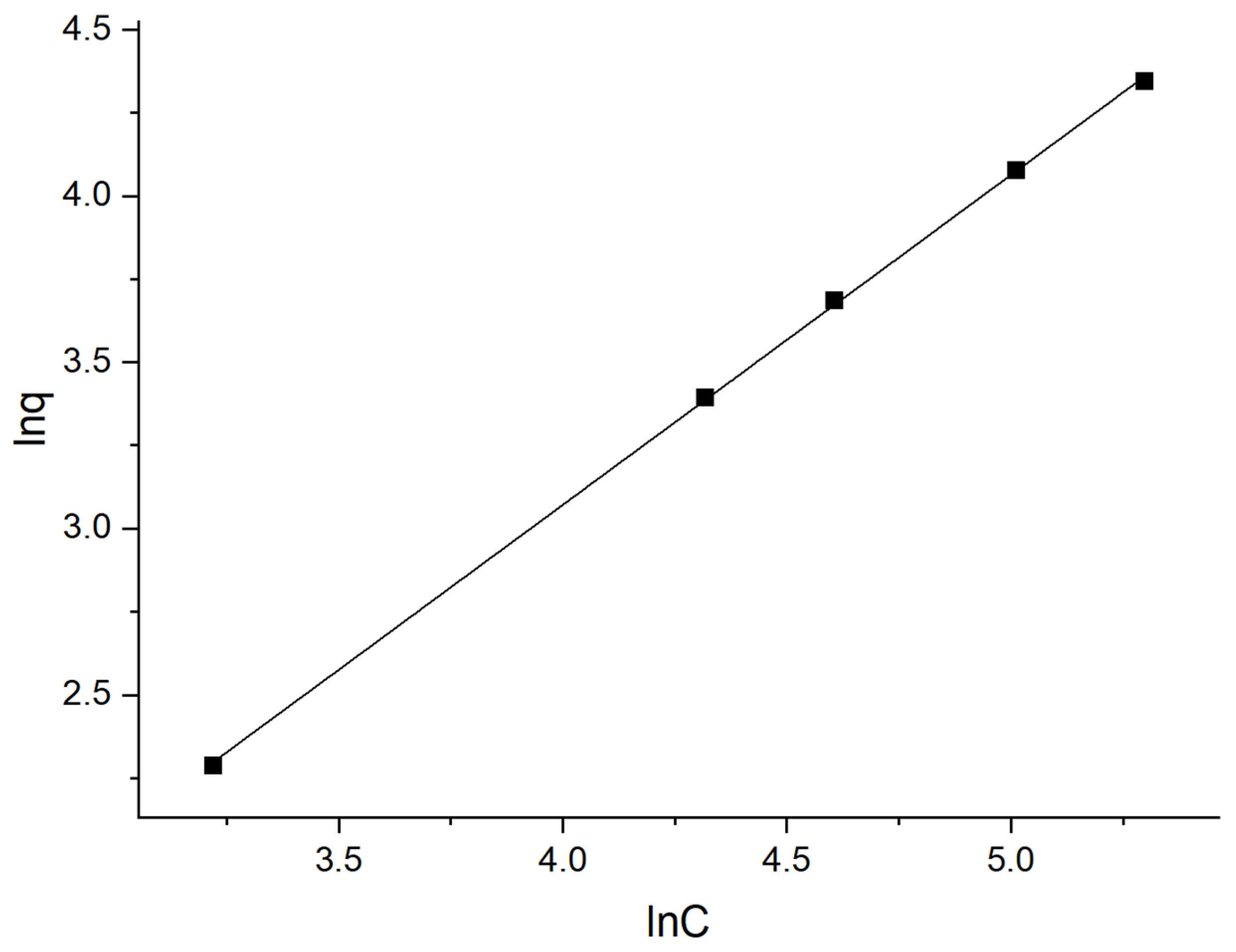
| Particle Size Index | Particle Size of Coal Gangue Raw Materials (μm) | Particle Size of Ball Milling 1 h (μm) | Particle Size of Ball Milling 4 h (μm) | Particle Size of Ball Milling 7 h (μm) | Particle Size of Ball Milling 10 h (μm) |
|---|---|---|---|---|---|
| mean particle size | 138.69 | 13.27 | 10.39 | 6.22 | 5.79 |
| D50 | 53.66 | 7.78 | 5.94 | 4.24 | 3.93 |
| D97 | 581.66 | 45.59 | 37.36 | 21.60 | 20.77 |
| Number | Time (min) | Temperature (°C) | Rate (r·min−1) | Acid Concentration (mol·L−1) | Absorbance (L·g−1·cm−1) | Solution Concentration after Adsorption (mg·L−1) |
|---|---|---|---|---|---|---|
| 1 | 30 | 25 | 200 | 2 | 0.217 | 1.471 |
| 2 | 30 | 50 | 600 | 5 | 0.15 | 1.099 |
| 3 | 30 | 100 | 1000 | 8 | 0.058 | 0.404 |
| 4 | 135 | 25 | 600 | 8 | 0.095 | 0.691 |
| 5 | 135 | 50 | 1000 | 2 | 0.143 | 1.060 |
| 6 | 135 | 100 | 200 | 5 | 0.168 | 1.199 |
| 7 | 240 | 25 | 1000 | 5 | 0.105 | 0.849 |
| 8 | 240 | 50 | 200 | 8 | 0.121 | 0.938 |
| 9 | 240 | 100 | 600 | 2 | 0.178 | 1.255 |
| K1 | 2.974 | 3.011 | 3.608 | 3.786 | ||
| K2 | 2.950 | 3.097 | 3.044 | 3.147 | ||
| K3 | 3.041 | 2.857 | 2.312 | 2.032 | ||
| 0.991 | 1.004 | 1.203 | 1.262 | |||
| 0.983 | 1.032 | 1.015 | 1.049 | |||
| 1.014 | 0.952 | 0.771 | 0.677 | |||
| R | 0.030 | 0.080 | 0.432 | 0.585 |
| Sample | BET Specific Surface Area (m2·g−1) | Micropore Volume (ml·g−1) | Total Pore Volume (ml·g−1) | Remark |
|---|---|---|---|---|
| <0.5 mm raw material | 12.7696 | 0.00021 | 0.02465 | micropore < 1.483 nm; total pore ≦ 172.079 nm |
| materials after ball milling for 7 h | 16.3612 | 0.0066 | 0.0579 | micropore ≦ 1.93 nm; total pore ≦ 142.86 nm |
| acid-modified material | 29.9398 | 0.0123 | 0.0712 | micropore ≦ 1.91 nm; total pore ≦ 121.86 nm |
| Number | Oscillation Temperature (°C) | Oscillation Rate (r·min−1) | Oscillation Time (min) | Absorbance (L·g−1·cm−1) | Solution Concentration after Adsorption (mg·L−1) |
|---|---|---|---|---|---|
| 1 | 30 | 150 | 10 | 0.124 | 0.956 |
| 2 | 40 | 225 | 30 | 0.043 | 0.287 |
| 3 | 40 | 75 | 30 | 0.046 | 0.308 |
| 4 | 40 | 150 | 20 | 0.040 | 0.264 |
| 5 | 30 | 225 | 20 | 0.062 | 0.432 |
| 6 | 40 | 225 | 10 | 0.063 | 0.442 |
| 7 | 50 | 75 | 20 | 0.093 | 0.673 |
| 8 | 40 | 150 | 20 | 0.042 | 0.279 |
| 9 | 50 | 225 | 20 | 0.049 | 0.331 |
| 10 | 30 | 75 | 20 | 0.066 | 0.468 |
| 11 | 50 | 150 | 10 | 0.066 | 0.463 |
| 12 | 40 | 150 | 20 | 0.041 | 0.274 |
| 13 | 40 | 75 | 10 | 0.068 | 0.484 |
| 14 | 30 | 150 | 30 | 0.049 | 0.331 |
| 15 | 40 | 150 | 20 | 0.040 | 0.264 |
| 16 | 50 | 150 | 30 | 0.045 | 0.303 |
| 17 | 40 | 150 | 20 | 0.041 | 0.274 |
| Sources of Variation | Quadratic Sum | Degree of Freedom | Mean Sum of Square | F Value | p Value | Significance |
|---|---|---|---|---|---|---|
| Regression model | 0.44 | 9 | 0.049 | 3.91 | 0.0429 | Significant |
| A(T) | 0.022 | 1 | 0.022 | 1.75 | 0.2280 | Non-significant |
| B(v) | 0.024 | 1 | 0.024 | 1.95 | 0.2051 | Non-significant |
| C(t) | 0.16 | 1 | 0.16 | 12.50 | 0.0095 | Significant |
| AB | 0.023 | 1 | 0.023 | 1.88 | 0.2127 | Non-significant |
| AC | 0.054 | 1 | 0.054 | 4.34 | 0.0757 | Non-significant |
| BC | 0.0001103 | 1 | 0.0001103 | 0.008853 | 0.9277 | Non-significant |
| A2 | 0.12 | 1 | 0.12 | 9.66 | 0.0171 | Non-significant |
| B2 | 0.005457 | 1 | 0.005457 | 0.44 | 0.5292 | Non-significant |
| C2 | 0.023 | 1 | 0.023 | 1.81 | 0.2200 | Non-significant |
| Pure error | 0.00018 | 4 | 0.000045 | |||
| Total deviation | 0.53 | 16 |
| T (°C) | Solution Concentration after Adsorption (mg·L−1) | Adsorption Capacity qe (mg·g−1) |
|---|---|---|
| 303.15 | 0.326 | 39.870 |
| 308.15 | 0.287 | 39.885 |
| 313.15 | 0.248 | 39.901 |
| 343.15 | 0.225 | 39.870 |
| T (°C) | ΔG0 (KJ·mol−1) | ΔH0 (KJ·mol−1) | ΔS0 (J·mol−1·K−1) |
|---|---|---|---|
| 303.15 | −12.115 | 19.727 | 40.03 |
| 308.15 | −12.641 | ||
| 313.15 | −13.225 | ||
| 343.15 | −14.774 |
Disclaimer/Publisher’s Note: The statements, opinions and data contained in all publications are solely those of the individual author(s) and contributor(s) and not of MDPI and/or the editor(s). MDPI and/or the editor(s) disclaim responsibility for any injury to people or property resulting from any ideas, methods, instructions or products referred to in the content. |
© 2024 by the authors. Licensee MDPI, Basel, Switzerland. This article is an open access article distributed under the terms and conditions of the Creative Commons Attribution (CC BY) license (https://creativecommons.org/licenses/by/4.0/).
Share and Cite
Ren, X.; Shu, X.; Geng, W.; Li, P.; Xu, Y. A Study on the Adsorption of Methylene Blue by Acid-Modified Coal Measures Kaolin. Processes 2024, 12, 773. https://doi.org/10.3390/pr12040773
Ren X, Shu X, Geng W, Li P, Xu Y. A Study on the Adsorption of Methylene Blue by Acid-Modified Coal Measures Kaolin. Processes. 2024; 12(4):773. https://doi.org/10.3390/pr12040773
Chicago/Turabian StyleRen, Xiaoling, Xinqian Shu, Weiguo Geng, Peng Li, and Yane Xu. 2024. "A Study on the Adsorption of Methylene Blue by Acid-Modified Coal Measures Kaolin" Processes 12, no. 4: 773. https://doi.org/10.3390/pr12040773




